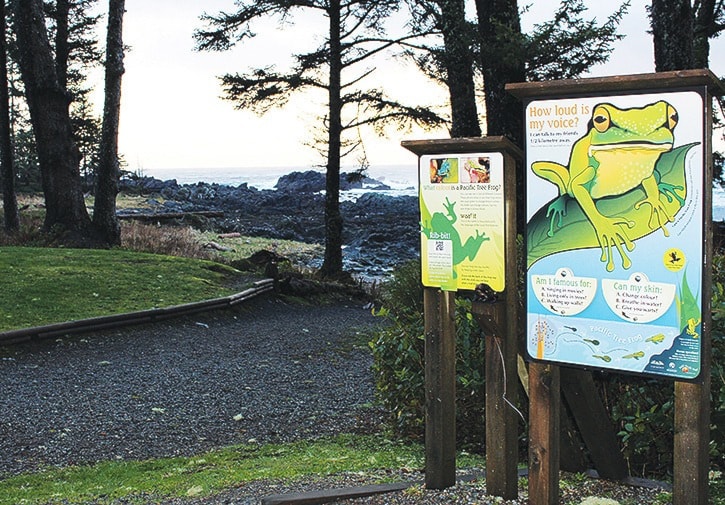Visitors to the Coast are looking to do more than put their feet in the sand.
Educational tourism is trending as tourists are seeking out fulfilling experiences that don’t just yield shareable photos of picturesque landscapes but new knowledge as well.
With its uniquely diverse range of ecosystems and cultures, the West Coast seems well positioned to capitalize on this trend and local leaders are strengthening their collective lure.
Recognizing that tourism is a resource they all share, Tofino, Ucluelet, Tla-o-qui-aht First Nation and Ucluelet First Nation are working together to promote educational tourism on the West Coast rather than compete as individual communities.
These communities struck a regional learning committee in 2014 and, armed with roughly $60,000—$29,950 from the Island Coastal Economic Trust, $24,950 from Pacific Salmon Treaty funds and $5,000 from the Clayoquot Biosphere Trust—kicked off the first phase of an educational tourism initiative.
This work included an inventory of regional assets and tools, a capacity building strategy and an education market research strategy report put together by Royal Road University.
Royal Roads presented the results of its research last March and the committee used this information to design their next step towards boosting the region’s educational tourism capacity.
The committee recently announced the launch of a second phase, which will include developing a website and reaching out to universities and other educational organizations to attract more programming to the region.
The Clayoquot Biosphere Trust (CBT), which was a key player in phase one’s work, was pegged as the right resource to mine in the next stage and has signed on to fulfill a $70,000 contract for phase two.
The CBT’s executive director Rebecca Hurwitz told the Westerly she’s excited about the project and that it will help establish regional governance for the educational tourism initiative and create strong marketing and communication tools to support program delivery.
She added the new website would serve as a valuable online hub to help tourists hook up with the educational opportunities they’re looking for.
“We want folks to be coming here for educational tourism opportunities but, right now, when they Google that from outside the region they don’t land on a page that actually captures all of the opportunities that are available here,” she said.
“We want to showcase all of those on one website and link them to the organizations and the communities that are delivering them so that people can really see the full suite of opportunities that are here and then we can start to grow that more and more.”
Hurwitz said the West Coast boasts a strong roster of local organizations that provide solid educational offerings for vacationers and educational groups to feast on.
“It’s important for us to be working with the destination marketing organizations locally and with other folks who are doing marketing in our region so that we’re really tied in with who the visitors are and we’re able to appeal to those demographics,” she said.
She said the West Coast’s educational tourism pursuit would bring benefits to locals outside of economic success.
“One of the models that we are testing is how we can ensure that the new opportunities are benefitting locals,” she said. “If groups or universities are bringing field study programs out here, we’d love to see that locals are also participating in the education that’s being offered.”
She added the market for educational experiences is booming and fits perfectly with the West Coast’s strengths.
“It’s really leveraging what we’ve already got going on and it’s a great opportunity to build out those shoulder seasons as well, rather than trying to attract more visitors in the summertime I think there’s a lot of programs that would be a good fit in the fall and winter,” she said.
“We have a diverse range of ecosystems and communities that people are hungry to learn about and that puts us at an advantage…It’s not just the ecosystems, it’s also our communities of people and the arts and culture that we have to offer.”
She expects phase two to be wrapped up within a year and said locals should be excited about what’s in store.
“They’re going to have new opportunities for their own education and also be meeting with new visitors who are bringing their skills and experience to our area,” she said.
Ucluelet First Nation director of operations Iris Frank said the CBT is the perfect group to take on the task.
“The CBT has a regional mandate,” she said. “It is natural to house this initiative with the CBT who will continue to collaborate with each community.”
Tofino Mayor Josie Osborne has been thrilled with the West Coast’s collaboration.
“Our communities worked jointly to understand the local education assets and needs, as well as educational tourism opportunities,” she said. “By working together, we have laid the foundation to diversify and build the region’s learning economy as well as provide new opportunities for local residents.”
Ucluelet Mayor Diane St. Jacques agreed.
“We are excited to see the economic impacts of this project, as well as the other opportunities that are opened up as a result of these next steps,” she said.
The regional committee has invited the Ahousaht, Hesquiaht and Toquaht First Nations to participate in phase two, according to Hurwitz.
